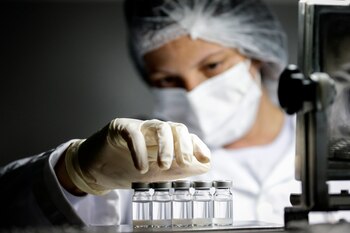
Access to vaccines was one of the obstacles that countries had to overcome as soon as the first formulations for COVID-19 were authorized in emergency.
More than a year after the first doses began, and although a large number of people in most countries have already been immunized and are protected against severe forms of the disease, in many parts of the world there is still a need to purchase vaccines to apply them to the population.
In this context, a new vaccine developed at the Massachusetts Institute of Technology (MIT) and the Beth Israel Deaconess Medical Center in the United States can contribute to these efforts by offering a cheap, easy-to-store and effective alternative to preventing the disease, according to early studies.
In a recent article published in the journal Science Advances, researchers reported that the vaccine, which comprises fragments of the SARS-CoV-2 spike protein arranged in a virus-like particle, caused a strong immune response in animal tests and protected them against viruses.
As the developers explained, the vaccine was designed so that it can be produced by yeast, using fermentation facilities that already exist around the world. The Serum Institute in India, the world's largest vaccine manufacturer, now produces large quantities of the vaccine and plans to conduct a clinical trial in Africa.
“There is still a very large population that does not have access to vaccines against COVID. Protein-based subunit vaccines are a well-established, low-cost technology that can provide a steady supply and is accepted in many parts of the world,” said J. Christopher Love, Professor at Raymond A. and Helen E. St. Laurent, a specialist in Chemical Engineering at MIT and a member of the Koch Institute for Comprehensive Cancer Research and the Ragon Institute of MGH, MIT and Harvard.
Love and Dan Barouch, director of the Center for Virology and Vaccine Research at Beth Israel Deaconess Medical Center (BIDMC) and professor at Harvard Medical School, are the lead authors of the article. They are supported in research by MIT graduate students Neil Dalvie and Sergio Rodríguez-Aponte, and Lisa Tostanoski, from a postdoctoral program at BIDMC.

Love's laboratory, in close collaboration with Barouch's laboratory at BIDMC, began work on a COVID-19 vaccine in early 2020. Their goal was to produce a vaccine that was not only effective but also easy to manufacture. To that end, they focused on protein subunit vaccines, a type of immunization consisting of small fragments of viral proteins. Several existing vaccines, including one against hepatitis B, were manufactured using this method.
“In places around the world where cost remains a challenge, subunit vaccines can address that,” said Love. They could also address some of the doubts about vaccines based on newer technologies.”
Another advantage of protein subunit vaccines is that they can often be stored in refrigerators and do not require ultra-cold storage temperatures, as do those for messenger RNA.
“Authorized SARS-CoV-2 vaccines continue to be less available in low- and middle-income countries due to insufficient supply, high costs and storage requirements,” the authors noted in the publication in their conclusions. Global immunity could still benefit from new vaccines that use safe and widely available adjuvants, such as alum and protein subunits, suitable for low-cost production in existing manufacturing facilities.”
For their subunit vaccine, the researchers decided to use a small part of the SARS-CoV-2 tip protein, the receptor binding domain (RBD). Early in the pandemic, animal studies suggested that this protein fragment alone would not produce a strong immune response, so in order to make it more immunogenic (that is, to drive an even better immune response), the team decided to display many copies of the protein in one virus-like particle.

For this purpose, they chose the hepatitis B surface antigen as their scaffold and demonstrated that, when coated with RBD fragments of SARS-CoV-2, this particle generated a much stronger response than the RBD protein alone.
The researchers also wanted to make sure that their vaccine could be manufactured easily and efficiently. Many protein subunit vaccines are manufactured using mammalian cells, which may be more difficult to work with. The MIT team designed the RBD protein so that it could be produced by Pichia pastoris yeast, which is relatively easy to grow in an industrial bioreactor.
Each of the two components of the vaccine, the RBD protein fragment and the hepatitis B particle, can be produced separately in yeast. Then, to each component, the researchers added a specialized peptide tag that binds with a tag found on the other component, allowing the RBD fragments to bind to the virus particles after each is produced.
“One of the key things that separates our vaccine from other vaccines is that the facilities for manufacturing vaccines in these yeast organisms already exist in parts of the world where vaccines are still most needed today,” Dalvie said.
Once the researchers had their vaccine candidate ready, they tested it in a small trial in non-human primates. For these studies, they combined the vaccine with adjuvants that are already used in other vaccines: either aluminum hydroxide (alum) or a combination of alum and another adjuvant called CpG.
In those studies, the researchers demonstrated that the vaccine generated levels of antibodies similar to those produced by some of the authorized COVID-19 vaccines, including the Johnson and Johnson vaccine. They also found that when animals were exposed to SARS-CoV-2, viral loads in vaccinated animals were much lower than those seen in unvaccinated animals.

And while the formulation that was tested in a Phase 1 clinical trial in Australia used an RBD fragment that was based on the sequence of the original SARS-CoV-2 strain that emerged in late 2019, the researchers then incorporated two mutations (similar to those identified in the natural variants Delta and Lambda) that the team previously found to improve production and immunogenicity compared to the ancestral sequence, for planned phase 1/2 clinical trials.
The approach of attaching an RBD immunogen to a virus-like particle offers a “plug-and-show” like system that could be used to create similar vaccines, the researchers say.
“We could make mutations that were observed in some of the new variants, add them to the RBD but keep the whole framework the same and create new candidate vaccines,” explained Rodriguez-Aponte, who stressed that “this shows the modularity of the process and the efficiency with which it can edit and create new candidates.”
If clinical trials show that the vaccine provides a safe and effective alternative to existing RNA vaccines, the researchers hope that it will not only be useful for vaccinating people in countries that currently have limited access to vaccines, but also allow the creation of boosters that would offer protection against a wider variety of SARS-CoV-2 variants or other coronaviruses.
KEEP READING
Últimas Noticias
Debanhi Escobar: they secured the motel where she was found lifeless in a cistern
Members of the Specialized Prosecutor's Office in Nuevo León secured the Nueva Castilla Motel as part of the investigations into the case

The oldest person in the world died at the age of 119
Kane Tanaka lived in Japan. She was born six months earlier than George Orwell, the same year that the Wright brothers first flew, and Marie Curie became the first woman to win a Nobel Prize

Macabre find in CDMX: they left a body bagged and tied in a taxi
The body was left in the back seats of the car. It was covered with black bags and tied with industrial tape
The eagles of America will face Manchester City in a duel of legends. Here are the details
The top Mexican football champion will play a match with Pep Guardiola's squad in the Lone Star Cup

Why is it good to bring dogs out to know the world when they are puppies
A so-called protection against the spread of diseases threatens the integral development of dogs




